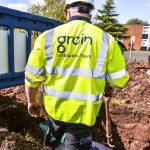UPDATE 2 Years On – Lace Hill’s Wait for Faster Broadband in Buckinghamshire
A large build of new homes on the outskirts of Buckingham (England) is still struggling to be recognised as needing faster broadband via the state aid fuelled Connected Counties project, which is because the local authority and BT were unable to identify its existence.. even though it’s kind of hard to miss.
A few years ago the southern edge of Buckingham town was still little more than lush green fields (pictured), flanked by an industrial estate. But drive through the same area today and you can’t help but notice a sprawling development of new build homes, shops and many other facilities. In fact you’d have to be pretty blind to miss it as many of the homes have been built.
Advertisement
The Lace Hill development, which was once batter known as Windsor Park before a dispute over its name got in the way, is expected to become home to 800+ new properties by completion in 2016 (expected to represent around 12% of Buckingham’s population). A consortium of firms, including big names like Bovis and Barratt, are involved in its construction.
The development first came to our attention in May 2014, after residents complained that their brand new properties had not been connected to even a basic broadband and phone service (here). After many months the issue was finally resolved, but it left locals with a weak ADSL2+ connection where speeds tended to vary from 5Mbps to 12Mbps (e.g. Cabinet 25 / Postcode: MK18 7RG).
Unfortunately all of this happened far too late for the area to be included as part of the Phase 1 Connected Counties (CC) contract, which is working to ensure that 90% of premises in Hertfordshire and Buckinghamshire can access faster “fibre broadband” (FTTC/P) connectivity by March 2016. The local authority also initially reasoned that BT could cover it as part of their commercial deployment, although the telecoms giant appeared unwilling.
But residents of Lace Hill remained hopeful that a second Connected Counties contract with BT, which was signed in May 2015 (here), might finally include their seemingly neglected development. So you can imagine their surprise at being told in September 2015 by CC that “the postcode data for the development was not available at the time of our Open Market Review“. The review has been carried out during H2 2014, which is after many homes had already been built and occupied.
Advertisement
The postcode data for Lace Hill should have been supplied by BT (Openreach) for the OMR which, as per our May 2014 article, clearly did know about the development. Never the less one local campaigner was rather oddly told by Openreach in July 2015 that, “we are not aware of the extent and size of the development on Lace Hill.”
Matthew King, Resident of Lace Hill, told ISPreview.co.uk:
“We have been trying to engage with BT, Connected Counties and the house builders on the continued lack of workable broadband now since 2013 on the development. BT have indicated that the site is not commercially viable (despite their being around 800 properties), Connected Counties who have funding to fill this type of “gap” are suggesting that it should be commercially viable for BT, which would be a barrier to their funding, that is if we actually appeared on their records which we apparently don’t.
We have requested Connected Counties to include us in their data as it clearly falls within the scope of their Open Market Review that completed in late 2014, but they are unwilling or unable to do so and have yet to explain why. BDUK who oversee the funding have yet to respond to us on the questions of correcting the clearly incorrect data and on their obligation for the best return on investment for public funds that this clearly represents. And all parties are giving a variety of different, contradictory, reasons as to how this issue has happened. We find it appalling is that no-one is willing, 3 years on, to give us any firm commitment on when this might be resolved.
We are now having to resort at looking at the possibility of funding this as a community to enable residents’ children to carry out school work (some families have to take children to the library to do online school work), work from home and run businesses. Given the cost per property that BT have indicated (around £62.50 per household) it begs the question of why, given the huge boost to the Counties coverage statistics, no-one is jumping to cover this. It also begs the wider question as to how appropriately the Government funding is being spent and how accurate their statistics actually are.”
The issue is at least recognised by the Connected Counties project, although there are no solid plans to resolve it using state aid.. yet.
A Connected Counties Spokesperson told ISPreview.co.uk:
“This situation is one we are well aware of. Given the time that has passed since the initial project scoping and procurement, there is inevitably a number of new housing developments that did not appear in the original dataset. This situation is replicated across the country, and locally we continue to work with partners to resolve this and other issues on new builds.
We understand the government is in discussion with the EU on securing a new state aid notification for broadband. We will then look at how new postcodes and areas not included in the coverage data can be included. This will need to be done via an open market review after the government secures state aid notification.
Naturally, we are keen to work with telecom suppliers to resolve such issues by extending their commercial plans and will look at state funding and other procurement solutions where necessary to facilitate increased coverage of superfast connectivity across Buckinghamshire.”
The above statement on “state aid notification” is a reference to the Government’s on-going efforts to secure public funding for future Broadband Delivery UK projects (here and here), such as via a possible third extension contract to the CC scheme. But sadly this has been have been stalled since the original umbrella agreement with the EU expired at the end of June 2015.
In fairness there is a long standing problem with the delay between a new home being constructed/occupied and then later – often quite a few months later – being recognised in various regional databases, which is likely to be something that many new home owners have experienced (i.e. getting organisations to recognise a new postcode that isn’t in their database).
Advertisement
Equally it would be wrong to place all of the blame for this at BTOpenreach or the council’s feet because it’s the property developer(s) who hold the most responsibility for ensuring that their new homes are able to gain the best possible connectivity. Likewise homes buyers could have checked first, although property developers can’t always be relied upon to give the correct information.
An Openreach Spokesperson told ISPreview.co.uk:
“We understand the frustration of local residents at Lace Hill and continue to talk to developers about the options for providing superfast broadband to their homes.
The development was built after Openreach’s commercial programme in Buckingham completed and was not factored into our original plans as the developer had not made us aware of these new homes. When surveys were carried out for the Broadband Delivery UK (BDUK) programme, the post-code did not exist and the development was not included in intervention plans.
We recognised these issues in 2013 and provided a gap-funded proposal to the developer for the 250 homes on the site but it was not taken up at the time.
Since then hundreds more homes have been built and provided with copper lines. We’re currently working with the developer to try and find a solution to bring fibre broadband to around 750 premises in Lace Hill.”
It’s crucial to point out that Lace Hill is by no means the only development to fall into such a trap and many new builds, especially those of scale that occur in more rural areas, are becoming a victim of the same administrative oversight. Others would simply call it negligence.
In the meantime it’s been suggested that one alternative path might involve a developer partnership to co-fund the build of a new “fibre broadband” cabinet with Openreach. The last quote on this was done two years ago for a privately funded cabinet with David Wilson (developers), which came out at £12,000 and was rejected (reasons unknown).
However today’s build is now significantly larger and a new quote is already being prepared that would require at least two DSLAMs, but there’s currently no certainty that the developers will accept it. In other words, the wait continues.
One bit of good news is that the Government has started to push local authority planning departments to ensure that they do not approve future applications unless a developer has included provision for superfast broadband (here), although such plans are often approved years ahead of development and so it may take some time for this to have any real impact.
Meanwhile a forthcoming EU requirement means that, from 2017 onwards, all new builds will need to be “high-speed broadband ready“, although once again this will only impact future and not current development projects. But at least in the future we should see fewer situations like the one at Lace Hill.
UPDATE 13th November 2017
Local resident Matthew King has been back in contact to say that the FTTC cabinets funded by the developers’ consortium and Openreach (BT) have finally gone live some 18 month later. Apparently current estimates for the whole site are that this should offer at least 40Mbps+ download, with many closer to 60Mbps+. Around 100 households are believed to have already ordered or be about to order the service (initial uptake).
Mark is a professional technology writer, IT consultant and computer engineer from Dorset (England), he also founded ISPreview in 1999 and enjoys analysing the latest telecoms and broadband developments. Find me on X (Twitter), Mastodon, Facebook, BlueSky, Threads.net and Linkedin.
« Three UK Scraps Legacy Mobile Tariffs – Forces Pricey Upgrade

















































Comments are closed